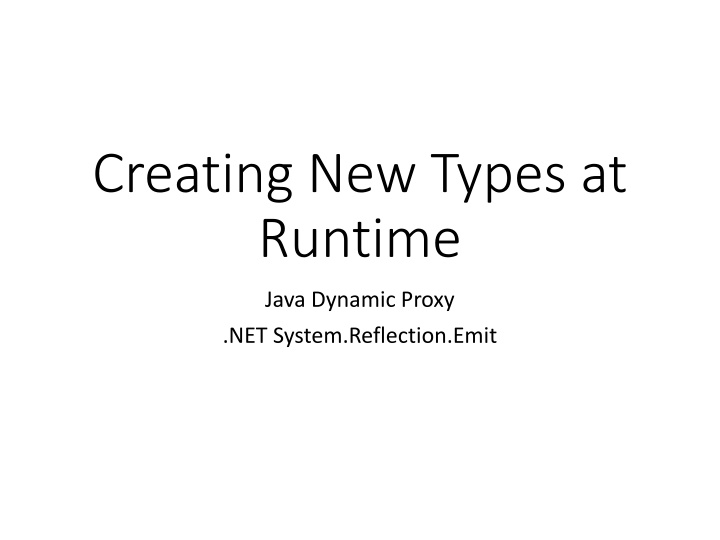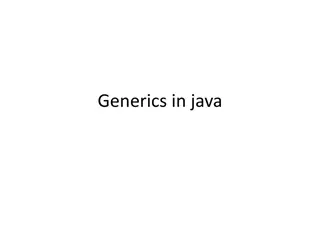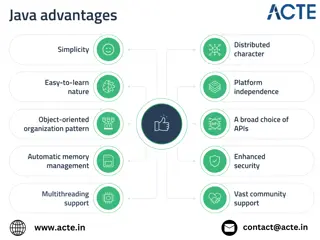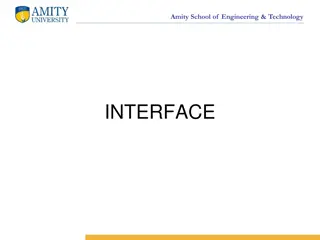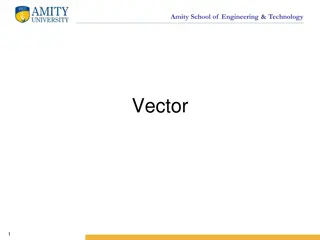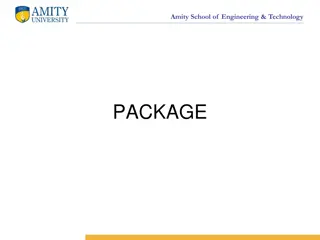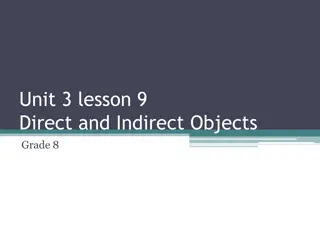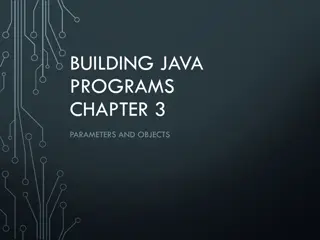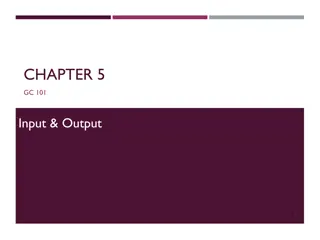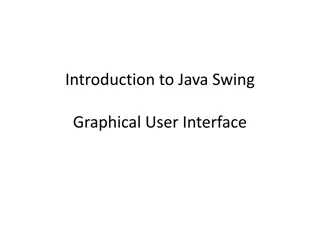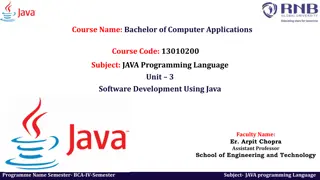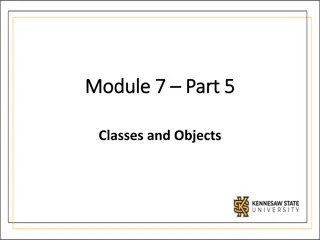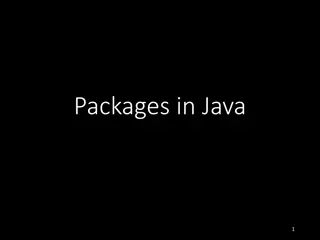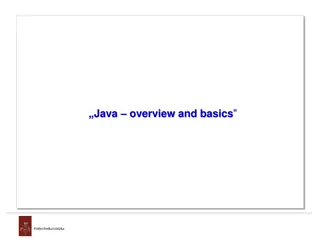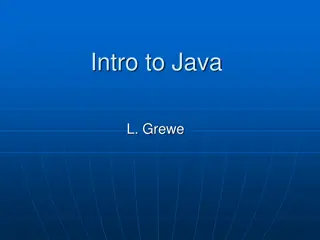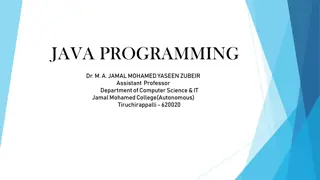Dynamic Proxy in Java for Type-Safe Proxy Objects
Learn about creating dynamic proxy classes in Java to implement interfaces at runtime without pre-compilation, enabling type-safe proxy object creation for method invocations. This allows for flexible and efficient handling of method calls through uniform interfaces.
Download Presentation

Please find below an Image/Link to download the presentation.
The content on the website is provided AS IS for your information and personal use only. It may not be sold, licensed, or shared on other websites without obtaining consent from the author.If you encounter any issues during the download, it is possible that the publisher has removed the file from their server.
You are allowed to download the files provided on this website for personal or commercial use, subject to the condition that they are used lawfully. All files are the property of their respective owners.
The content on the website is provided AS IS for your information and personal use only. It may not be sold, licensed, or shared on other websites without obtaining consent from the author.
E N D
Presentation Transcript
Creating New Types at Runtime Java Dynamic Proxy .NET System.Reflection.Emit
Classical Proxy Implementation vs Dynamic Proxy A Classical Proxy Implementation requires the Programmer to write the code of the Proxy class for every Original Interface and compile it. A dynamic proxy class is a class that implements a list of interfaces specified at runtime when the class is created and immediately instantiated
Example: Using a Classic Proxy for Timing of Methods of IMath objects public interface IMath { int add(int a, int b); int mult(int a,int b); } public class Math implements IMath{ public int add(int a, int b) { return a+b; } public int mult(int a, int b){ return a*b; } } }
public class MathTimingProxy implements IMath{ private IMath target; public MathTimingProxy(IMath target) { this.target=target; } public int add(int a,int b){ long start = System.nanoTime(); int result = target.add(a,b); long elapsed = System.nanoTime() - start; System.out.println("Execution of method add in " + elapsed + " ns"); return result; } public int mult(int a,int b){ long start = System.nanoTime(); int result = target.mult(a,b); long elapsed = System.nanoTime() - start; System.out.println("Execution of method mult in " + elapsed + " ns"); return result; } }
public class Main { public static void main(String[] args) { IMath target = new Math(); IMath mathTimingProxyInstance = new MathTimingProxy(target); mathTimingProxyInstance.add(3,4); mathTimingProxyInstance.mult(5,7); } }
Java dynamic proxy A dynamic proxy class is a class that implements a list of interfaces specified at runtime such that a method invocation through one of the interfaces on an instance of the class will be encoded and dispatched to another object through a uniform interface. Thus, a dynamic proxy class can be used to create a type-safe proxy object for a list of interfaces without requiring pre-generation of the proxy class, such as with compile- time tools. java.lang.reflect.InvocationHandler java.lang.reflect.Proxy Class java.lang.reflect.Proxy acts as a factory to create new classes that implement some given interfaces (dynamic proxy classes), and also their instances (proxy instances) Each proxy instance has an associated invocation handler object, which implements the interface java.lang.reflect.InvocationHandler. Method invocations on an instance of a dynamic proxy class are dispatched to a single method in the instance's invocation handler, and they are encoded with a java.lang.reflect.Method object identifying the method that was invoked and an array of type Object containing the arguments. This process allows implementations to "intercept" method calls and reroute them or add functionality dynamically. The dynamic proxy can act as a Decorator pattern, where the proxy wraps invocations with additional functionality
The InvocationHandler Interface public interface InvocationHandler { Object invoke(Object proxy, Method method, Object[] } The job of an invocation handler is to actually perform the requested method invocation on behalf of a dynamic proxy. He gets a Method object (from the Reflection API) and the objects that are the arguments for the method call. In the simplest case, he can just call Mehod.invoke() or add pre or post processings.
Proxy object an instance of the dynamic proxy class created automatically at runtime The service of the original Object is called by Reflection
Creating a dynamic proxy in Java Create a proxy instance for some interface Foo: InvocationHandler handler = new MyInvocationHandler(...); Foo f = (Foo) Proxy.newProxyInstance( Foo.class.getClassLoader(), // ClassLoader new Class[] { Foo.class }, // implemented interfaces handler); // invocationhandler A dynamic proxy class is a class that implements a list of interfaces specified at runtime when the class is created. A proxy interface is such an interface that is implemented by a proxy class. A proxy instance is an instance of a proxy class. The unqualified name of a proxy class is unspecified. The space of class names that begin with the string "$Proxy" should be, however, reserved for proxy classes. A proxy class extends java.lang.reflect.Proxy. A proxy class implements exactly the interfaces specified at its creation, in the same order.
Example: Using a Dynamic Proxy for Timing of Methods import java.lang.reflect.Proxy; public class Main { public static void main(String[] args) { IMath target = new Math(); IMath mathTimingProxyInstance = (IMath) Proxy.newProxyInstance( Main.class.getClassLoader(), new Class[] { IMath.class }, new TimingHandler(target)); System.out.println("type of proxy is + mathTimingProxyInstance.getClass().getName()); mathTimingProxyInstance.add(3,4); mathTimingProxyInstance.mult(5,7); } }
Implementation of Dynamic Timing Proxy import java.lang.reflect.InvocationHandler; import java.lang.reflect.Method; public class TimingHandler implements InvocationHandler { private Object target; public TimingHandler(Object target) { this.target = target; } public Object invoke(Object proxy, Method method, Object[] args) throws Throwable { long start = System.nanoTime(); Object result = method.invoke(target, args); long elapsed = System.nanoTime() - start; System.out.println("Execution of method "+method.getName()+" finished in "+elapsed +" ns"); return result; } }
More on Java dynamic proxy To read more about java dynamic proxy: https://docs.oracle.com/javase/8/docs/technotes/guides/reflection/proxy.html https://www.baeldung.com/java-dynamic-proxies
.NET System.Reflection.Emit
System.Reflection.Emit System.Reflection.Emit namespace: A mechanism to define new types (metadata and MSIL code) at runtime! https://learn.microsoft.com/en-us/dotnet/framework/reflection-and- codedom/emitting-dynamic-methods-and-assemblies System.Runtime.Remoting.Proxies.RealProxy https://learn.microsoft.com/en- gb/dotnet/api/system.runtime.remoting.proxies.realproxy?view=netfra mework-4.8.1 System.Reflection.DispatchProxy https://learn.microsoft.com/en- us/dotnet/api/system.reflection.dispatchproxy?view=net-8.0
